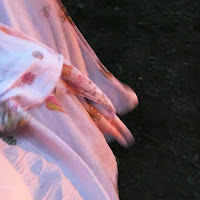The ancient Egyptians would use them to bury the dead. The Greek Empire would line the halls of grand buildings. It wasn't until the Middle Ages where the tapestry became a status symbol, yet were used to insulate. The Lady and the Unicorn series of tapestries are by far the most well known and an example of the most reproduced as tapestries, pillows and framed art. Reproductions allow us to enjoy superb copies of the original work of art for less cost (sometimes cheaper than buying a framed print.) You just have to know where to look!
The Noblemans Way of Life reproduction tapestry that I have hung in our bedroom - this type of scene is called Mille Fleur, meaning a thousand flowers. (For reference, this reproduction cost $200)
I love using tapestries as art in my home to bring an area to life. Being a baller on a budget, you don't have to spend an arm and a leg. With research and patience you can find original tapestries, but you will pay and the scale will be on the smaller side. Typically original tapestries of a popular scene and larger in scale I've seen start at $2,000, whereas you can get a nice reproduction starting at around $200. Many original tapestries are in museums (though even museum house reproductions believe it or not.) Today you can find large reproduction collections of this ancient craft not only as wall art, but other bespoke home accessories such as throw pillows and armchairs. When it comes to wall art you can use vintage material, weavings, antique fabrics, or even plush velvet to dress your walls.
When purchasing reproductions think about the scale, because unlike originals, repros have lesser image quality because the technique is different. For example, when you have a 12' original tapestry that was woven thread-by-thread, then you shrink it down to a 4', the threads are in lower quantity and not as fine – it's the modern day idea of pixelation. Depending the source, the color will be duller than the original. This is something to think about when comparing an original tapestry to a reproduction, and also whether a fine print is more of what you are looking for. Most importantly always do your research.
I've used this 19th century french woven silk damask jacquard original tapestry in my dining room to fill the large walls and to add texture. This tapestry pattern features beautiful women holding a coat of arms with the crown & royal fleur de liz surrounded by scrolling foliage. (For reference, this original tapestry cost $350)
Advantages of tapestries or wall hangings in the home:
- Large wall hangings create a focal point that can help anchor a room or enhance the decor you already have. Think about selecting a tapestry based on the main colors of your room OR start with a unique tapestry then build a room around it based on colors and feeling
- Like in the medieval times, tapestries can add elegance to a room. Knowing the story of your tapestry will be a great conversation starter
- If your not into ornate tapestries see mid century modern, plush velvet, Swedish tapestries
- A tapestry can add warmth and texture to a room
- Tapestries or needlepoint wall hangings can also be used as a rug or decorative throw
- Need a headboard, use a tapestry behind your bed
When I purchased this reproduction needpoint tapestry, from Anastacias Antiques, I didn't realize my walls were a bit short for this massive piece of art. I improvised and decided to use it as a floor rug in my dining room. (For a reference point, this particular reproduction due to its condition, the cost was $300)
Here are some additional resources on where to purchase tapestries online:
Reproductions:
Originals:
Mixture of antique, vintage and reproductions:
When purchasing online always be sure to read the fine print to make sure you are getting what you are paying for - there is a difference between vintage, antique and reproduction. Sometimes many reproductions are 30-40 years old (which would make them vintage.)
To draw the eye up the wall and connect my bedding to my DIY bed canopy, I decided to use a vintage 1970s plush red floral bedspread to fill the space. I also used an antique 1800s ecclesiastical french altar banner hanging from the ceiling to anchor as a focal point. My grandmother's lace curtains add extra softness that flow down to the floor. This is an example of an unexpected way to use tapestries and wall hangings.
Learn more about symbolism seen the medieval tapestries:
Symbolism of Animals and Birds » (Not particularly about tapestries, but more symbols found in churches)

1960s Rare Swedish Vintage wall hanging tapestry with an ancient Roman motif in blue, black and white.
1950's Greek wool bedspread that is used as a rug.
Floral Still Life Painting Tapestry is really grand and elegant
Beauty And The Beast Wall Tapestry Wall Hanging that is a mix of Moroccan and Egyptian
This minimalistic modern fiber art tapestry is in absolute contrast to ornate medieval tapestries.
French Millefleurs Tapestry The Dancer Silk Screened a Louvre Museum Reproduction
William Morris Needlepoint Tapestry Pillow - a different take on the traditional tapestry
I love how this vintage mid century modern velvet wall hanging is used across this bed!
Vintage Plush Cotton Tapestry with deer is used in an unexpected way over a chair
Want something more mod? How about this Mid-century vintage wall tapestry from the 1960-1970s?



















































